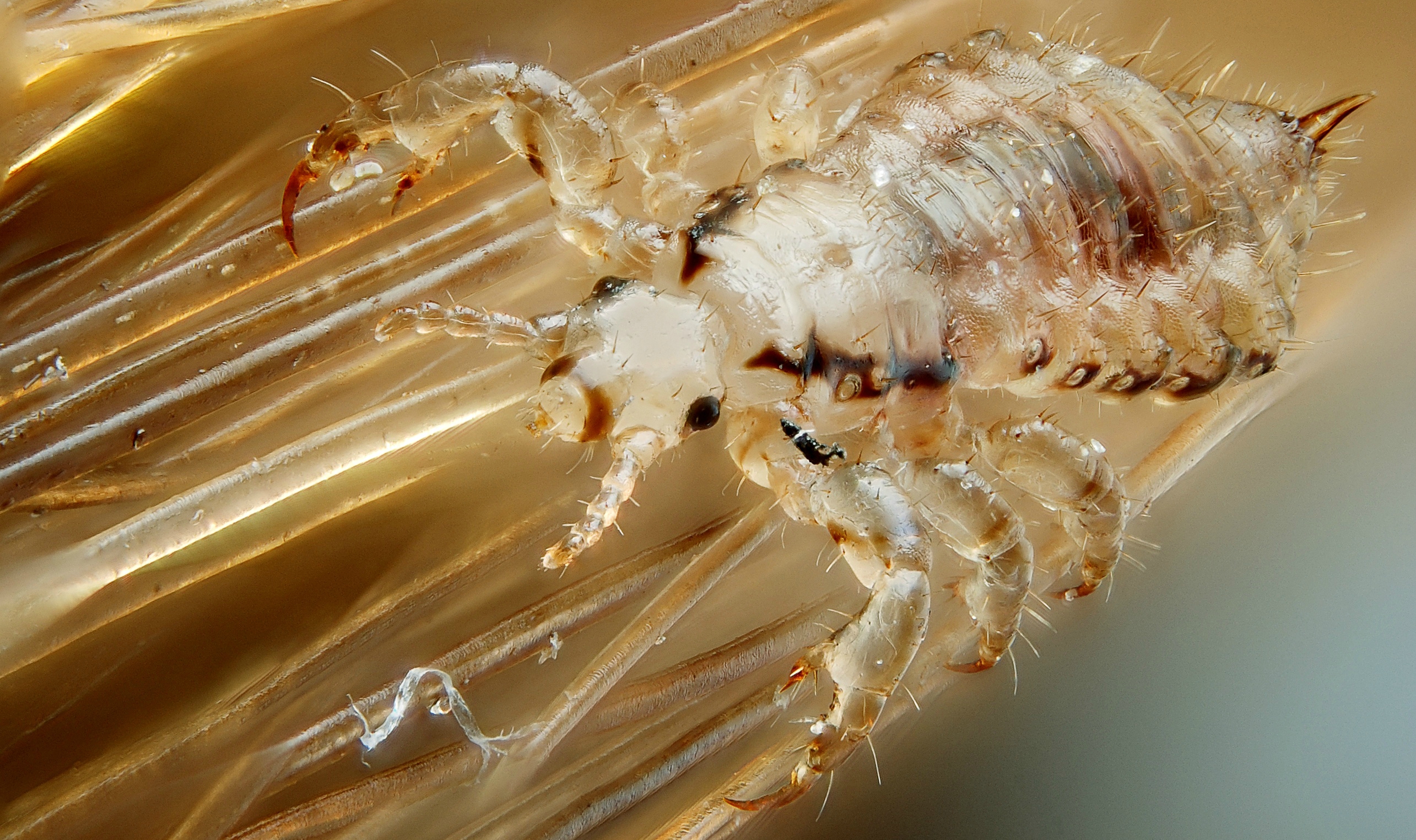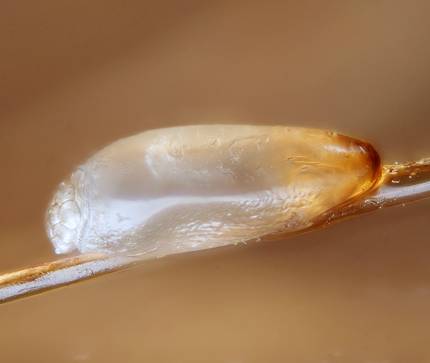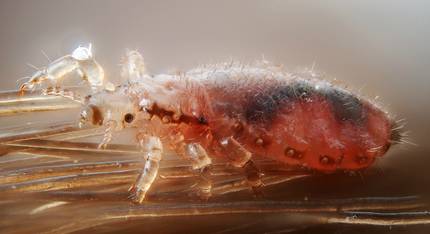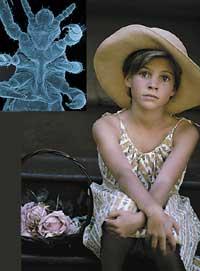Against lice
2017/05/04 Mendia Gonzalez, Ana - Erizaintzan graduatua Iturria: Elhuyar aldizkaria

The lice are arthropods of six legs of order Phthiraptera, with more than 3,000 species on the planet. The biology of human infestants is the best known. Thus, three species of lice stand out: the fillet or Pediculus capitis, the body louse or Pediculus corporis and the pubic louse or the pediculus pubis. However, of all of them, the most prestigious around us is the monkey.
Head lice are mandatory ectoparasites in humans, that is, the only host of these insects is man. They live by absorbing human blood. And the three stages of development of their life cycle are carried out in the host: at the beginning of the cycle, mature females lay between 3 and 10 eggs daily, for about 23-30 days, of which, between 5 and 10 days, nymphs are born, which become adults, which reproduce and begin the cycle.
Eggs require an incubation temperature higher than 22ºC, so lice place eggs at a maximum of one centimeter of the scalp, especially on buds, neck and nape. However, not all eggs that lay female lice are habitable. The lice eggs are thick, round and brown.
Mature spikes reach 3-4 mm and have a similar color to that of the host, while eggs are noticeably smaller and often mixed with hair bran. Lice eggs attach to the hair thanks to an adhesive substance and its vertices, making it more difficult than removing the skin.
Diagnosis and symptoms of pediculosis
It is said that there is an active lice infestation when it is verified that there are live mature lice, since the mere presence of orchards cannot be considered as an active infestation, since not all individuals who only have eggs have to develop the infestation. It can also be determined that the presence of lice can be verified at first glance, either by magnifying glasses or by fasting comb, although of all these methods the comb of the dishes is the most successful diagnostic method.
The most common symptom of infestation is scalp growth, although some asymptomatic children usually appear. Scratching is the result of saliva injected by lice to absorb blood. However, since the lice begin to absorb blood in the first infestation until the itching appears it may take more than a month, as the body needs time to develop the first reaction. This makes it common for the child to be full of lice for diagnosis in the first infestation. In repeated infestations, however, itching appears in the early days of infestation, making it easier for the diagnosis to be made as soon as the information appears.
The intensity of growth is variable and sometimes the child's sleep pattern can become agitated. Scratching can also lead to infection of the injured areas. Infection is usually caused by the pathogen Staphilococcus aureus. On the other hand, it should be noted that pediculosis affects the psychosocial and cultural sphere, since the social stigma around lice allows children and families to assume responsibilities, concerns and embarrassment.
Although hundreds of research has been conducted on lice contamination, the transmission of lice remains a controversial key, although it is known that lice are contaminated by both mental contact and formites (objects or inanimate substances capable of transmitting infectious organisms). However, it is admitted that the head-to-head mechanism is the main source of contamination, as lice are unable to jump, fly or swim. In addition, outside the host only have a two-day survival, so it is suggested that lice become more easily contaminated by fomites.
Regarding the risk of infestation, it has been stated that variables such as socioeconomic level, cultural habits, type of population, etc. have something to do. Thus, it seems that the prevalence increases in unfavorable socioeconomic conditions, in very concentrated populations, in situations where personal hygiene is not cared for and in areas with limited health resources. On the contrary, pediculosis has no strict limits: it affects people of all races, ages, sexes and cultures.
Prevention and treatment of pediculosis

In general, three are the keys to therapeutic management: mechanical treatment, management of the environment and pharmacological treatment with pediculicides.
Treatment with comb is effective if done properly. Therefore, it should be noted that, in general, it is recommended the use of metal combs of little distance between the teeth, in addition to favoring the simultaneous use of the comb of the garden with the hair conditioner or other similar lubricating element. It should also be noted that once the information is diagnosed, treatment should be performed two or three times a week, at least two weeks and each session should last 30 minutes. However, it is unforgettable that, in addition to effective treatment, it is the most economical, natural and effective safe prevention measure, so it is essential to take root in families the habit of inspecting children with garden comb.
Regarding the management of the environment, it should be noted that the American Association of Pediatrics does not recommend a thorough and exhaustive cleaning of the housing. However, it is advisable to wash with hot water the objects that have been in contact with the infested child in the previous 24-48 hours, especially those near the head: combs, sheets, heads, towels, etc. In addition, it is important to teach children how to use fomites. In this way, children should be aware that they should pay attention to sharing personal items for their hygiene. It should also be noted that sleeping in the same bed is a risk factor.
Chemical treatment should only be performed when there is clear evidence of lice, i.e., pediculicides should not be used as prevention. Neurotoxic pediculicides have been used throughout history: chemicals such as pyrethrins and malation that kill parasites by damaging the nervous system of lice. However, the effectiveness of these substances has decreased in recent years, because lice have developed resistance to these neurotoxic pediculicides, due, among other factors, to the excessive use, misuse and sale of inefficient products.
As a consequence of the above, in addition to the creation of new drugs of neurotoxic effect, in recent years have developed pediculicides with physical mechanism of action, among which are drugs with capacity to “drown” lice (benzyl alcohol). However, a 100% obicide pediculicide has not yet been achieved, so even though drugs kill lice, lice eggs remain alive. Therefore, a second application of pediculicide and a mechanical treatment is necessary.
It is clear, therefore, that head lice are not enemies of all kinds; patience, entrepreneurship and free communication are the most effective weapons at our disposal to combat the epidemic. Therefore, in addition to taking steps in treatment, the current work consists of incineration of the social stigma associated with lice and reinforcing general preventive measures.
Bibliography

Gai honi buruzko eduki gehiago
Elhuyarrek garatutako teknologia





